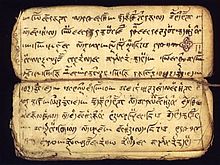Lepcha script
The Lepcha script is an Abugida used by the Lepcha people to write their language .
According to a legend, the Lepcha script was designed by a Sikkim king in the 17th century. It is a direct descendant of the Tibetan script and was initially written vertically from top to bottom , following the example of the Chinese script . Later they switched to horizontal writing direction - the letters were rotated with the writing direction, which resulted in today's typeface.
This rotation creates some unusual properties among the Indian scripts . Consonants at the end of a syllable are not marked with a virama , but instead with special diacritics that are placed above the preceding consonant. An exception is the sign for an ng at the end of a syllable. This is etymologically derived from Chandrabindu and is written before the preceding consonant and before the preceding vowel. So the syllable king would be written as ngik .
